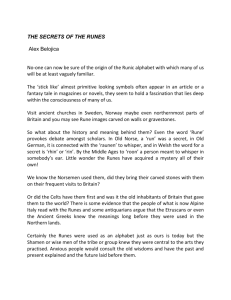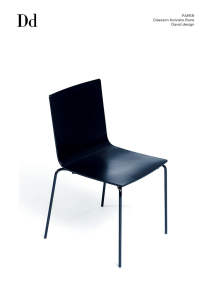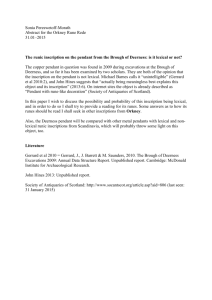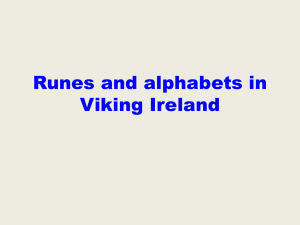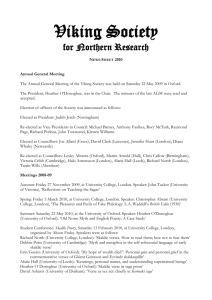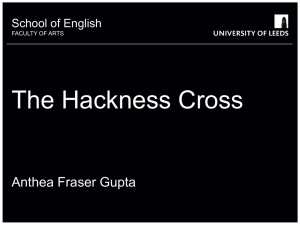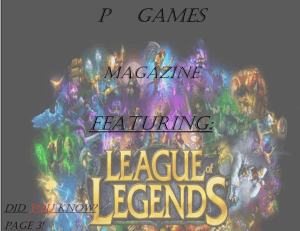here
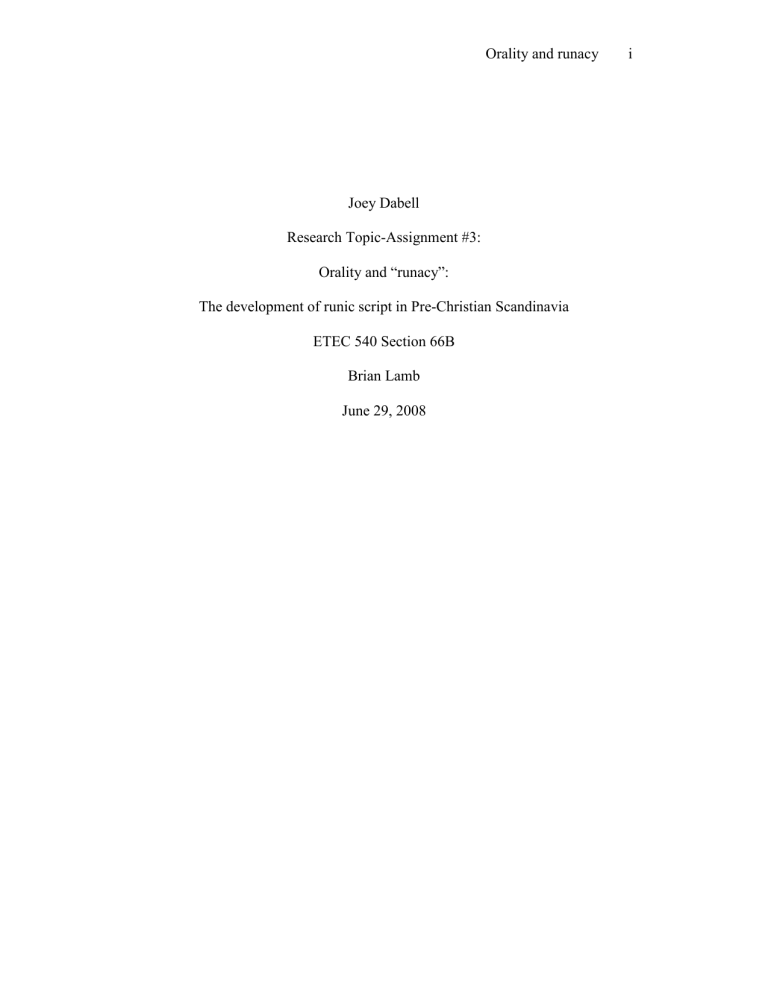
Orality and runacy
Joey Dabell
Research Topic-Assignment #3:
Orality and “runacy”:
The development of runic script in Pre-Christian Scandinavia
ETEC 540 Section 66B
Brian Lamb
June 29, 2008 i
Orality and runacy 1
Introduction
The runic alphabet began its life in Northern Europe during the period coinciding with the late Roman Iron Age. Runes were used in various forms in Pre-Christian
1
Scandinavia over several centuries. Runic inscriptions are found in mainland Europe and
England, but the oldest are found in Scandinavia.
The runic alphabet in Scandinavia evolved through three main periods (Moltke,
1985, p. 24). The first runic period covers a portion of the Roman Iron Age, and spans the time from the birth of Christ until around 700 C.E. This period used a 24-character alphabet commonly called the “ elder futhark
” 2
. The second period covers the Viking
Age (650 C.E. to 1150 C.E.) which used a reduced, 16-character alphabet commonly called the “ younger futhark ”. The third period covers the Middle Ages (from approximately 1100 C.E). This period returned to a larger and reordered alphabet and is now commonly referred to as the “ medieval furthork
” 3
.
This paper includes some general discussion of runes. The primary focus of the research topic is the first runic period and the development of the elder futhark including how it was influenced by, and its influence upon culture and society in pre-Christian
Scandinavia.
1 Christianity was practiced in other areas during this time, but had not yet arrived in Scandinavia.
2 Each rune was given a name that begins with the sound value of the first runic character in the name. The name “futhark” is an Anglicized interpretation of the sound values for the first 6 runes in the runic alphabet,
: “ f ehu”; “ u ruz”; “ th urisaz”; “ a nsuz”; “ r aidho”; and “ k enaz”. The sound value of the third rune,
, is interpreted as “th”.
3 In the third runic period, the sound value for the fourth rune has changed, hence the change in name of the alphabet from futhark to “futh o rk”.
Source: DabellJ (UBC/MET-ETEC540, 2008)
Orality and runacy 2
Orality and “Runacy”
During the first and second runic periods Scandinavia was a pagan society. Runes were used for a variety of purposes ranging from everyday use, to pagan ritual and magic.
Spoken language consisted of localized dialects but was generally rooted in Proto-Norse.
Communication during this time would also be strongly tied to an oral culture where story tellers used verbal imagery to help make their stories more memorable to the listener. Poetry and prose recorded in runic script used kennings . As a story telling technique kenning has roots in Proto-Norse oral culture. It has been carried over to written text and is still used by writers today to direct their readers’ attention. Storytellers attempt to create a vivid image for the reader by identifying something by describing it, or by use of metaphor, rather than calling it directly by name. For example “slayer of giants” might be one way of referring to the god Thor. Similarly, the god Odin has been referred to by more than 200 names including “friend of wealth”, and “eagle headed one”. Brink (2005) argues that while written language reflects planned thought, language in an oral society must provide additional functions including passing on memories and knowledge in the form of songs and myths, and to express power in the form of commands.
Some understanding of how individuals within the culture think is often a prerequisite to understanding these allusions. There seems to be some irony here. The imagery that made the stories memorable to Proto-Norse society now make it very difficult for modern researchers to agree on a single interpretation of many ancient runic inscriptions. The ancient Norse writers’ ways of thinking in choosing their phrases to create these mental images can probably never be fully understood.
Source: DabellJ (UBC/MET-ETEC540, 2008)
Orality and runacy 3
Moltke (1985, p36) observes that all alphabets have a name for each letter. This is also true of the elder futhark. Each rune has both a name and a sound value. Ong
(2002, p. 86) discusses the idea of sound-symbols, where a picture represents something signified by the sound. He also claims that pictures can serve as memory aides (p. 85).
In the case of runes the name of the rune begins with the sound value for the rune character. For example, the “th” rune, , has the name “thurs”, meaning “giant” in the
Proto-Norse language. The “d” rune, , is named “dagaz”, meaning day, and the “n” rune, , is named “naudir”, which means need. The first runic period shared its space with a still largely oral culture. Perhaps oral memory aides were more meaningful.
Remnants of prose written in runic script have been found that weave the names of the runes into poems. It is likely that as use of runes began to spread, poems would have developed as a way to remember the runic alphabet.
Liane Gabora
4
, a cultural evolution researcher at UBC (UBC Reports, June 3,
2008) believes that “the underlying mechanisms by which culture evolves are superficially similar yet profoundly different from those through which living things evolve”. One of these differences is that in cultural evolution acquired change is passed on to others rather than lost as it can be in biological evolution. We can apply similar notions to the evolution of language and literacy. From this progression, understanding people’s cognitive evolution is necessary to understanding the evolution of orality and literacy.
4 During my own research, I was struck by how researchers of the runic alphabet seemed to show its evolution almost through a kind of genetic mutation. But Gabora, claims that we tend to borrow methods for studying cultural evolution from methods for biological evolution. Her argument that this is not appropriate since “humans innovate strategically” seems to be a valid one.
Source: DabellJ (UBC/MET-ETEC540, 2008)
Orality and runacy 4
Rune Technology
Ong says (2002, p80) that “writing is a technology, calling for the use of tools and other equipment”. Moltke (1985) believes that the runic alphabet was originally intended for use on wood. His argument is based on the fact that early runic characters were made up only of straight lines.
This idea certainly seems plausible since most people living in the period would have carried a knife. Carving the straight lines of the runic characters would have been relatively easy, requiring minimal skill. Anyone who has carved in wood will know that it is much more difficult to carve curves or irregular shapes across the grain.
In the latter part of the first runic period surfaces for writing rune were extended to stone. Presumably some stone carvers would have used hammers and chisels to make their mark. Other stone carvers used picks to chip out the marks. Runes were also used on metal amulets called bracteates. Goldsmiths would use punches to mark the surface of the metal, or would use dies and caste the metal which was worn as jewelry.
Runes as a technology themselves also evolved over time and through experimentation. Runic script was generally written continuously. There were no breaks or punctuation. Runes were generally read from left to right, but were also often written bustrophedon style, alternating left to right, then right to left. When written right to left, the runes themselves were also written backwards. Rune writers also used “code runes” to keep messages secret (Stoklund, Nielsen, Holmberg, Fellows-Jensen, 2006) from unintended readers.
Source: DabellJ (UBC/MET-ETEC540, 2008)
Orality and runacy 5
Origins and Early Uses of Runic Script
The runic alphabet needed a catalyst to bring it into existence. Some researchers believe that commerce drove the invention of runic script. Moltke claims that runic script originated in the first centuries C.E. in Denmark (1985, p. 64). It was influenced by contact with Mediterranean cultures, and is most closely connected to the Roman alphabet. The elder futhark developed at least in part, as a result of the trade ties between the Danes and the Roman military posts along the Rhine. Scandinavian traders needed a way to identify goods, destination, buyers and sellers. Many early examples of everyday use of runes appear to be tags or labels found at historical sites of commerce such as the port of Bryggen in Bergen, Norway.
Trade with the Roman Empire brought cultural changes including changes to the forms of the runic alphabet. As the Roman Empire began to decline Scandinavians would need to travel farther and more often. To manage this change it makes sense that runes would have become part of everyday use in shipping ports. Ports would also have served as gateways through which use of runes began to spread more widely to the remote inland regions. Since inland regions were remote and dispersed, it is also not difficult to understand how localized forms of runes would have developed.
Seems likely that specialists skilled as rune writers and readers may have been necessary roles in early Scandinavian society. A trade would have developed around the profession of runic reading and writing. Rune carvers did not necessarily know how to read runic script. Goldsmiths, stone masons, etc. were not necessarily literate. They would often copy from something that was written by a literate person.
Source: DabellJ (UBC/MET-ETEC540, 2008)
Orality and runacy 6
Magical Runes
Ong (p.33, p 92) claims that oral peoples tend to think of names as having power over things, or of writing as having magical or religious powers. Today, illiterate South
Pacific cargo cults still believe that shipping orders are magical and will make ships come and go. Writing and reading runes would have been something only few could do proficiently. This would have given runes a sense of mystery to the uninitiated.
The magic and mythology that was deeply ingrained in the culture may have caused some fear or distrust of writing. It isn’t hard to imagine that during early runic periods written runic script had magical qualities that might represent good or bad fortune in terms of health, harvest, or life in general. One could also speculate that a specialized knowledge of runic symbolism would have existed. Professionals experienced in the mystical properties of runes would have been called upon in much the same way as we call on medical professionals today.
Runes had symbolic values associated with the names. Members of the pagan society may have tried to assert influence over their gods and their environment by incantation and ritual. For some people “naudir” symbolized need and distress. Sending an object carved with this rune would have been intended to invoke poverty upon the recipient, an equivalent of modern day hate mail. An amulet carved with the “f” rune
“fehu”, , which means “wealth” would have been worn in an effort to bring good fortune.
While rune researchers generally agree that magic and cultism was not the primary role of runes, the idea of some use of runes to invoke powers of influence is widely supported (Spurkland, 2005, p. 11-13; Moltke, 1985, p. 77). Certainly for a
Source: DabellJ (UBC/MET-ETEC540, 2008)
Orality and runacy 7 society that relied primarily on oral communication, and that was generally not literate in the use of runes during the early period, the ability of rune writers and readers to communicate without words must have seemed magical.
Rune Stones
Runes carved on stone were used from around 400 C.E. to 1000 C.E. Rune stones were clearly intended to give some degree of permanence to the writing. The content of the writing was generally intended to commemorate or to declare. The most common surviving rune stones are monuments. Large rune stones
5
have been found with runes written to commemorate good harvest years, and curse anyone who damages or destroys the monument.
Other rune stones have been found that represent legal documents, for example providing records of inheritance of land. These rune stones also show that runic script enabled governments or landowners to set down written laws or proclamations. As runic script became more established laws that had originally been passed orally from generation to generation could now be recorded. Rune stones provide evidence that common regulations existed with respect to land use, and ownership rights, and inheritance.
There is an inherent assumption in runes on stone and how they where used that they were intended to be read by a more general population. This implies that rune literacy had grown significantly within the culture by this time. It also indicates that runes would have been involved in passing on knowledge, and in education.
5 The Stentoften Stone, in Blekinge, commemorates a “fruitful year” and promises “death by malevolent guile” to anyone who damages or destroys the stone (Moltke, 1985, p 140).
Source: DabellJ (UBC/MET-ETEC540, 2008)
Orality and runacy 8
Education and Runes
As use of runic writing gained more ground so would a desire to create more lasting messages that could be read by more people. In Scandinavia during this period formal schooling was rare. In most cases runic writing and literacy skills were learned in everyday sociocultural contexts and the learning process was mostly supported by the script itself.
Åke Olofsson (2008) gives evidence that could support this claim. A small piece of soapstone was found with two examples of runic writing carved into it. Both writings say similar things. One is well done with letters clearly formed apparently by an experienced hand. The other appears to be a less skilled attempt. It seems likely that writing was learned by copying and imitating, much as very young children learn early writing skills today.
Conclusion
As both rune literacy and culture evolved, so too would the rune forms and the tools for carving them. If we accept Moltke’s argument that rune technology began with knife and wood, then we also need to consider that variations that have been found in forms of runes were likely influenced, at least in part, by the technology in use in a particular region. And that the technology was in turn influenced by the culture of the region. Bolter (2005, p. 19) has claimed that the technical and cultural aspects of writing are intertwined. As runes became more visible, society began to realize their value for recording and passing on knowledge evidenced by more permanent applications such as carving on stone.
Source: DabellJ (UBC/MET-ETEC540, 2008)
Orality and runacy 9
References
Bolter, Jay David. (2001). Writing space: Computers, hypertext, and the remediation of print [2 nd
edition]. Mahwah, NJ: Lawrence Erlbaum.
Brink, S. (2005). Verba volant, scripta manent? Aspects of early Scandinavian oral culuture. In P. Hermann (Ed.), Literacy in medieval and early modern Scandinavia
(pp. 77-135). University Press of Southern Denmark.
Holck, J.P. (2005). Cultural contacts and genres of runes – Danish literacy until 1300. In
P. Hermann (Ed.), Literacy in medieval and early modern Scandinavia (pp. 136-150).
University Press of Southern Denmark.
Karlevi Runestone. (2008, May 17). In Wikipedia, The Free Encyclopedia . Retrieved
June 14, 2008, from http://en.wikipedia.org/w/index.php?title=Karlevi_Runestone&oldid=213003255
Moltke, Erik (1985). Runes and their origin: Denmark and elsewhere . Copenhagen:
Nationalmuseets Forlag
Olofsson, Å;. (2008). Early writing among ancient Vikings and today’s pre-schoolers: a cognitive developmental perspective on reading acquisition and alphabets as effective artefacts. Paedagogica Historica : International Journal of the History of Education,
44, (1–2),167–178.
Ong, Walter. (1982.) Orality and literacy: The technologizing of the word . London:
Methuen
Runic alphabet. (2008, June 8). In Wikipedia, The Free Encyclopedia . Retrieved June 14,
2008, from http://en.wikipedia.org/w/index.php?title=Runic_alphabet&oldid=217941470
Source: DabellJ (UBC/MET-ETEC540, 2008)
Orality and runacy 10
Sawyer, Birgit. (2000). The Viking-age rune-stones . Oxford University Press.
Spurkland, T. (2005). Viking age literacy in runes – A contradiction in terms? In P.
Hermann (Ed.), Literacy in medieval and early modern Scandinavia (pp. 136-150).
University Press of Southern Denmark.
Spurkland, T. (2001). Norwegian runes and runic inscriptions.
Oslo: Cappelen
Akademisk Forlag,
Stoklund, M., Nielsen, M.L., Holmberg, B., & Fellows-Jensen, G. (2006) Runes and their secrets: Studies in runology. University of Copenhagen: Museum Tusculanum Press.
Source: DabellJ (UBC/MET-ETEC540, 2008)

